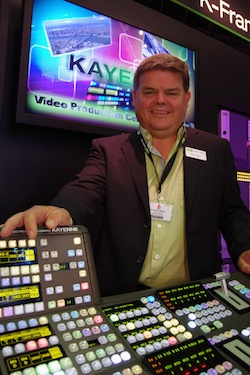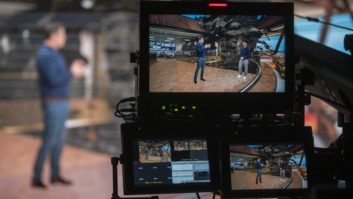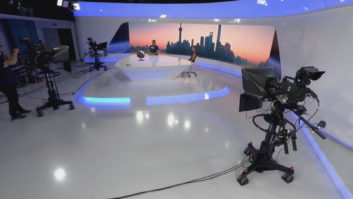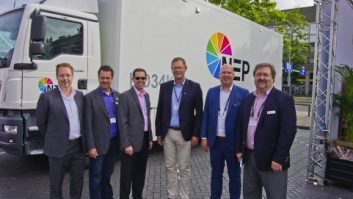
Grass Valley now supports a complete 1080p production workflow, from camera to playout, thanks to all-new hardware and software it is releasing this Autumn, and promises to be completely format agnostic, including 4k, by 2014, with everything built on IP and IT technology. At IBC it introduced multiple new products in its three main sectors: live, news and playout/distribution, to support 1080 50/60p workflows “all the way from the camera to distribution,” said Graham Sharp, CMO and Senior VP of Corporate Development. The only product line it didn’t refresh was routing, which already supported 1080p. “It’s the fruit of the last 18 months, since Grass Valley became an independent company,” he added. For live use, there is a brand new camera system (with three models), two new switchers, a new media server and a slo-mo/replay controller – all working at up to 1080 50/60p. They are all integrated “in a way you haven’t seen from Grass Valley before.” Pick Me The new LDX range of cameras is essentially the same hardware, differentiated by software into three models. Each uses three high-quality 2k CMOS sensors “giving us spectacular pictures, very high gain and very good signal to noise.” At 1080p the new Xensium-FT sensors match the sensitivity of its previous 1080i cameras, which means that if they are used for 1080i work, they are “one of two F stops ahead of the competition.” This light handling is particularly important for outside broadcasts, who Sharp claims will get “much better picture quality.” In future, the three sensors could be combined differently, to give higher-resolution pictures (theoretically up to 6k), via a software upgrade. The cameras also offer improved ergonomics and a revised user interface, based on feedback from existing users. There are lots of additional features for communicating with the control room (including a PickMe button to gain director’s attention), the ability to select any return feed from a Grass Valley routing switcher, and improved colour management. An Endless Returns feature enables the user to choose their own return channel via a Grass Valley routing switcher. The Scene Direct function enables the recall of camera scene-files directly from a Grass Valley switcher. There is also full remote control over all camera functions via any IP-link using Connect Gateway, while DigiTally is an all-digital remote Tally protocol over IP. The LDX cameras also have a much more comfortable shoulder mount (the ComfortPad), developed with physiotherapists and camera users. It should reduce the need for handheld users to subconsciously lift their shoulders to level shots, reducing muscle tension and enabling the camera to be held for longer, to prevent strain or injury. Another new feature is ArtTouch, which enhances the creative possibilities of the camera for live productions, offering an enhanced level of automated image processing, so that broadcasters can more easily achieve optimum camera performance. “This new generation of cameras has been developed with a strong focus on reducing operational costs, a major concern for many customers,” said Marcel Koutstaal, Senior VP of Cameras. Its new range of products allow “smart links between various roles in the production process, saving time and money during every phase of the production.” The LDX cameras cost between $60,000 and $100,000, for Première, Elite and Worldcam versions (upgradeable in software to the higher versions). Grass Valley will continue the LDK range for a while, for users who want to maintain their existing fleet. Switched on Grass Valley has introduced two new vision mixers, upgrades of its Karrera and Kayenne lines with all-new hardware and software, to cope with full 1080 50/60p production. Although 3Gbps 1080p is double the data rate, the new switchers don’t lose any of their capabilities, unlike some systems that use two M/E banks to process 1080p. The new systems, which will ship in November, are modular and easily upgradeable. Grass Valley has moved to designing all of its new systems using “a big bank of processing and making the software easy to upgrade,” to make its products more flexible and powerful, explained Sharp. “It’s green. It uses about half the power consumption of the previous range,” while being “much more powerful in terms of features and effects,” including built-in multi-viewer with capabilities similar to that already available in its Trinix NXT routers. This new modular architecture style applies to all of its new products. “You can start with what you need and upgrade,” said Sharp. Existing Karrera and Kayenne owners will be able to upgrade, but it will require a new chassis. Media Server There is also an all-new K2 Summit media server, with higher performance hardware to handle 1080 50/60p. It can also now work with Avid’s DNxHD codec. Also new is the Dyno S, its reworked slow-motion/replay controller (which needed new hardware for 1080p) has also gained considerable ergonomic improvements based on customer feedback. The K2 Summit now supports peer-to-peer connectivity, which means users can connect several together “without a costly and unreliable SAN in the middle.” This was something outside broadcast users had been asking for as SANs are not well suited to mobile applications. It will allow one channel or a Dyno S to access all media on any K2 Summits. There are also new versions of Grass Valley’s Stratus Media Workflow application, including Stratus for Live, which integrates all the components of the workflow, and enables broadcasters to create job-specific workspaces, so that instead of operators having to learn all the possible tools, there is just a specific tool for that job. For news, there is also a new Stratus for News, which is fully integrated with Grass Valley’s non-linear editor, Edius, to offer a “much faster, more efficient news workflow.” New Stratus features include the ability to add archive management to the jobs that can be combined into a single workspace through tight integration with popular archive management systems, including new search capabilities and partial file restore to retrieve only the needed portion of large full resolution media files. “The integrated archive management interfaces bring a new level of power to newsroom GV Stratus users’,” said Grass Valley’s Executive VP of Products, Charlie Dunn. “It means that every newsroom task, from ingest through simple editing all the way to archive and over the top distribution can be combined into a single powerful and totally configurable user interface, and all of that power can be made available within the context of the customer’s existing MOS compatible newsroom computer systems. The implications for workflow efficiency are enormous.” Nonlinear Production For playout, Grass Valley has now fully integrated Smart Playout Centre (one of the products created by PubliTronic, the Dutch automated playout system manufacturer Grass Valley bought last October) with its Stratus Media Workflow application and its media servers. The K2 Edge Smart Playout Centre is a platform from which multiple and varied automated, integrated playout channels can be configured. It is claimed to offer both lower initial capital outlays and lower operating costs. “It’s a new version. You can combine graphics, automation, asset management, transcoding and format conversion, and playout itself, into a single, efficient, productive application,” said Sharp. “We now have a range of playout applications, from traditional master control to our integrated application.” The Smart Playout Centre is shipping now, but Stratus for Playout (like the other new Stratus applications) will ship by the end of the year. For the future, Grass Valley believes the progress of IT systems, including increasing processor power, network bandwidths, and storage capacities, will enable production, post, and distribution operations to merge onto a single collaborative platform. It calls this Nonlinear Production, giving producers the power to create content once and distribute it across multiple platforms, faster and more efficiently than ever before. Stratus will be a key part of this, providing users with a unified graphical user interface, tools designed around tasks, a common environment from which to manage their facility, and new levels of efficiency. – David Foxwww.grassvalley.com







